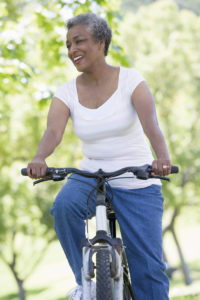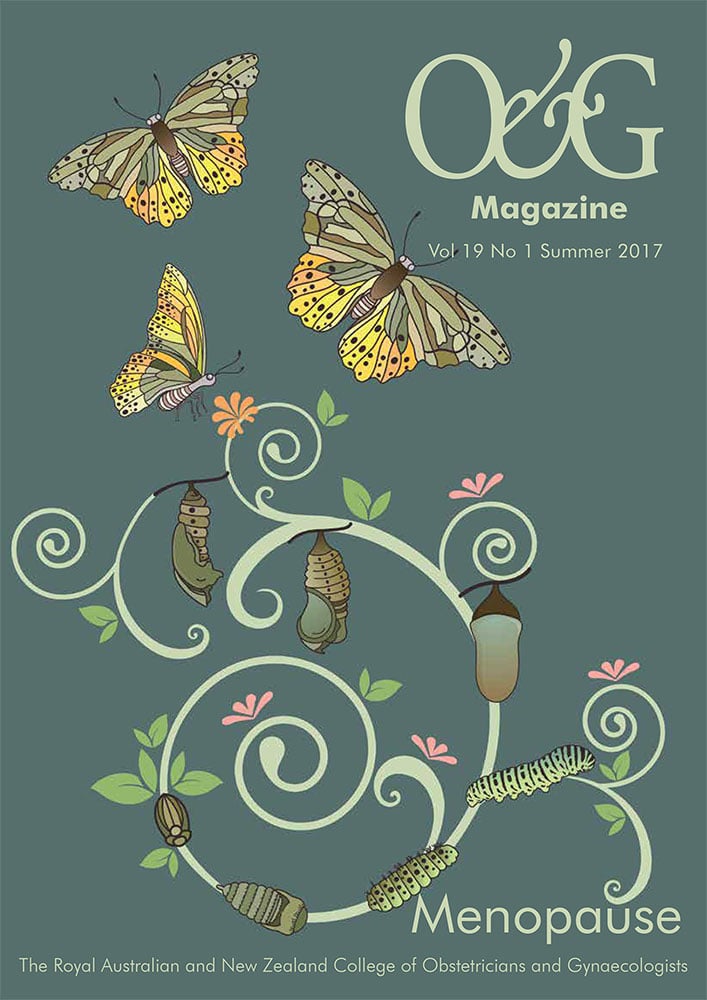The menopausal transition is characterised by a change in sex hormone levels where progesterone levels rapidly decrease, oestrogen concentrations are initially stable before fluctuating then declining; while follicle-stimulating hormone and luteinising hormone concentrations increase.1 2
These hormonal changes have significant implications for the health status of middle-aged and older women. Specifically, during the menopausal transition many women experience troublesome short- to medium-term symptoms that disrupt daily activities and reduce overall quality of life (QoL).3Furthermore, the sustained reduction in oestrogen levels postmenopause combined with the effects of ageing increases the risk of chronic disease,4 which impairs physical health and function ability leading to greater disability and a transition from independent to dependent living.
Menopausal hormone therapy (MHT) is the most effective treatment for the relief of symptoms and provides some protection from certain long-term chronic disease.5 6 However, MHT is not without risks7 and as such it is generally only taken short-term (one to five years). Additionally, some women may be advised not to commence MHT because of pre-existing conditions or not to continue with MHT because of poor benefit-to-risk profiles. For these women, physical activity (PA) may be an effective alternative therapy to minimise menopausal symptoms and improve health status throughout later life. This article briefly reviews the effects of PA on specific symptoms and QoL during the menopausal transition and factors influencing post-menopausal health status.
Effects on menopausal symptoms
Vasomotor symptoms
Most studies have examined hot flushes and night sweats and provide inconsistent findings for an effect of PA on the vasomotor symptoms.8 9 A systematic review of five randomised controlled trials (RCT), which included 733 menopausal women, reported no difference between PA versus no active treatment (standardised mean difference -0.10; 95% CI -0.33–0.13, three RCTs, 454 women) or between PA versus yoga on symptom frequency (standardised mean difference -0.03, 95% CI -0.45–0.38, two RCTs, n=279 women).10 Authors noted available evidence was low quality due to limitations in study design and imprecise methods. Therefore, evidence is currently insufficient to support the use of PA in the direct treatment of vasomotor symptoms alone. However, PA may be of indirect benefit through assisting with weight management where obesity is a known risk factor for vasomotor symptom frequency and severity.11
Psychological symptoms
Most, but not all,12 evidence is consistent that PA improves mood, anxiety, cognitive function and other psychological symptoms associated with menopause.13 Mansikkamaki et al14 using proportional odds ratios (PORs) from ordered logistic regression models (n=2606 menopausal women) observed that physically inactive women had an increased probability of anxiety/depressed mood (POR 1.44; 95% CI 1.26–1.65) and memory/concentration problems (POR 1.48; 95% CI 1.29–1.70) compared with women meeting recommended physical activity levels. Such findings remained significant after adjusting for confounding variables. Additionally, a four-month RCT that included previously low-active menopausal women (n=164) compared the effects of walking, yoga and a non-PA control group reported that the walking and yoga groups only improved positive affect (Cohen’s d 0.16–0.47 SD) and reduced negative affect (Cohen’s d -0.21–0.68). These effects were also observed to be associated with reductions in other menopausal symptoms and increases in aerobic fitness.15 Overall, evidence supports the use of PA in the direct treatment of psychological symptoms accompanying menopause.
Somatic symptoms
Bothersome somatic symptoms during menopause may include back pain, muscle pain and numbness, among others. Moilanen et al16 using multiple linear regression (n=1427 menopausal women; mean age 47 years) observed that after adjusting for background characteristics, reported participants that performed regular PA experienced fewer somatic symptoms compared with sedentary participants (beta coefficient 0.18, 95% CI 0.10–0.27). It was also observed that participants with chronic disease experience increased symptoms compared with asymptomatic participants. Additionally, a large cross-sectional study of women aged 46–55 years (n=2399) reported that after accounting for menopausal status women identified as being in the maintenance stage of change for PA were 21 per cent less likely to experience somatic symptoms compared with participants in the pre-contemplation, contemplation or preparation stages.17 However, these effects were also associated with body mass index (BMI) where participants with higher values experienced greater somatic symptoms. Not all studies examining the effect of PA on somatic symptoms in menopausal women report beneficial outcomes.18 As such, evidence does not support the use of PA in the direct treatment of somatic symptoms alone.
Quality of life
Higher PA levels during the menopausal transition are consistently associated with an improved QoL even after adjusting for other symptoms.19 Moilanen et al20 using ordinal regression in an eight-year follow-up study (n=1165 postmenopausal women; mean age 56 years) reported that participants with stable (Beta coefficient=1.46) or increased (Beta coefficient=1.49) PA levels relative to baseline had higher QoL scores than women whose physical activity levels declined. QoL was also influenced by stable weight (Beta coefficient=1.26) across the follow-up period. Additionally, Mansikkamaki et al21 reported after adjusting for education and BMI the POR for higher global QoL was 1.63 (9% CI 1.40–1.89) for menopausal women that achieve recommended PA levels compared with those less active. Therefore, the evidence supports the use of PA to improve QoL in menopausal women. The contrasting effects of PA on vasomotor and somatic symptoms compared with QoL suggests that PA may provide menopausal women with general symptom management rather than the therapy for specific symptoms themselves.22 This may also explain why vasomotor and somatic symptom covary with BMI and aerobic fitness, which are both strongly associated with PA levels.

Cycling is one of many ways to exercise outdoors. © Monkey Business Images, Shutterstock, 12530353.
Effects on factors influencing postmenopausal health status
Skeletal muscle mass and strength
Women aged 70–80 years demonstrate declines in muscle mass and strength of 20–35 per cent compared with young and middle-aged women.23 24 The loss of muscle mass and strength with age impairs functional status,25 promotes musculoskeletal disability24 and increases risk of both cardiometabolic disease26 and falls.27 PA may increase muscle mass and strength postmenopause by 9–13 per cent (a decade of age-related muscle loss) and 15–20 per cent (up to two decades of age-related strength loss), respectively, following as little as 10 weeks.28 The effects of these changes on overall physical health, functional ability and QoL are seriously underappreciated29 and should be a primary therapeutic target for maintaining or improving health status in all middle-aged and older women. Resistance training is the most effective means to stimulate muscle hypertrophy and develop strength. Many middle-aged and older women are apprehensive about participating in resistance training due to a lack of self-efficacy or fear of injury. To date, no studies have reported any adverse effects of appropriately prescribed and supervised resistance training in women of any age.
Bone health, fractures and falls
Bone mineral density (BMD) in postmenopausal women may increase through PA by a magnitude of 0–2 per cent over 1–2 years, while BMD in most control groups typically declines by around 1 per cent per annum.30 Additionally, a large meta-analysis by Qu et al29 – including 14 843 fractures from 22 cohort studies – reported an overall relative risk of fracture of 0.71 (95% CI 0.63–0.80) and a 38 per cent (95% CI, 0.54–0.69) and 28 per cent (95% CI 0.49–0.96) lower risk of hip and wrist fractures, respectively, in postmenopausal women with the highest PA levels compared with the lowest.31 Thus, participation in PA interventions to maintain, if not slightly improve, bone mass and reduce the risk of fractures is worthwhile. The most effective PA intervention for bone health involves resistance training combined with high-impact/weight-bearing activities.32
Considerable evidence indicates that falls are inversely related to PA levels in older adults, including postmenopausal women.33 Furthermore, falls are not random events, but can be predicted by a number of risk factors, including lower limb muscle strength, gait and balance, all of which can be improved with appropriate PA.34 A meta-analysis of 17 RCTs (n=4305 postmenopausal women) reported that PA was associated with pooled estimates of the rate ratios of 0.63 for all injurious falls (95% CI 0.51–0.77), 0.70 for falls resulting in medical care (95% CI 0.54– 0.92), and 0.39 for falls resulting in fractures (95% CI 0.22–0.66, 6 trials).35 PA interventions that include resistance training with balance and mobility activities that challenge stability are most effective for falls prevention in older adults.36 37

Walking has shown to be a beneficial form of physical activity that improves menopausal symptoms. © FamVeld, Shutterstock, 484254748.
Effects on cardiometabolic health and mortality
PA is highly important for both the prevention and/or management of cardiometabolic disease.38 where it has a clear dose-dependent effect and inverse relationship with mortality.39 Postmenopausal women that are more physically active and/or have higher levels of fitness demonstrate less weight gain, reduced waist circumference, decreased abdominal obesity, higher HDL cholesterol, lower blood pressure and improved fasting glucose.40 41 Furthermore, physical activity is inversely associated with all-cause mortality in both older men and women. However, it appears that this relationship is stronger for women than men and that benefit can be achieved from even low-activity levels.42 A combination of moderate intensity aerobic PA and high-intensity interval training (HIIT)43 is most effective for improving cardiometabolic risk factors mortality risk reduction.

Yoga may be beneficial in the treatment of some menopausal symptoms. © Pressmaster, Shutterstock, 207970339.
Summary and physical activity recommendations
Regular participation in PA is essential for healthy ageing, but is particularly important for middle-aged and older women to facilitate the transition through menopause and prevent and/or manage chronic disease related to oestrogen deficiency and ageing. Where PA has not been demonstrated to have a direct effect on specific menopause symptoms, it may provide benefit through assisting to modify risk factors for symptom development, such as BMI and aerobic fitness. Regardless, PA supports menopausal women by improving overall QoL.
Given the substantial health benefits associated with PA, women should be strongly encouraged and supported to commence regular PA from 40 years of age (if not earlier) to develop physiological reserves in preparation for the deleterious effects of menopause and subsequent ageing on health status and functional ability.44 Regular PA for all women should involve both aerobic and resistance training combined with flexibility and balance activities as described in considerable detail elsewhere.45 However, the precise prescription for each type of PA should vary based on the participant’s age, menopausal stage (for example, pre-, peri- and postmenopause), and individual risk profile.
Although otherwise healthy older adults are not at greater risk of injury from participation in PA,46 it is essential that risks for adverse PA-related events and existing comorbidities are identified and appropriately managed. Exercise scientists and exercise physiologists accredited with Exercise and Sports Science Australia (AES and AEP, respectively) hold a minimum three-year Bachelor qualification and have the knowledge, skills and competencies to design, deliver and evaluate safe and effective exercise interventions for people, including women in all stages of menopause.
Finally, although evidence that regular PA provides considerable health benefits regardless of age, gender and health status is more than compelling, long-term PA adherence in the community is typically low. As such, it is critical that any PA intervention has a strong focus on achieving behavioural change if life-long health benefits are to be achieved.47
References
- McKinlay SM, Brambilla DJ, Posner JG The normal menopause transition. Maturitas. 1992;14,(2):103-15.
- Sherman BM, West JH, Korenman SG. The menopausal transition: analysis of LH, FSH, estradiol, and progesterone concentrations during menstrual cycles of older women. J Clin Endocrinol Metab. 1976;42(4):629-36.
- Moilanen J, Aalto AM, Hemminki E, et al. Prevalence of menopause symptoms and their association with lifestyle among Finnish middle-aged women. Maturitas. 2010;67(4):368-74.
- Rosano GM, Vitale C, Marazzi G, Volterrani M. Menopause and cardiovascular disease: the evidence. Climacteric. 2007;10(Suppl 1):19-24.
- Schierbeck LL, Rejnmark L, Tofteng CL, et al. Effect of hormone replacement therapy on cardiovascular events in recently postmenopausal women: randomised trial. BMJ. 2012;345: e6409.
- Gambacciani M, Levancini M. Hormone replacement therapy and the prevention of postmenopausal osteoporosis. Prz Menopauzalny. 2014;13(4):213-20.
- Utian WH, Woods NF. Impact of hormone therapy on quality of life after menopause. Menopause. 2013;20(10):1098-105.
- Guthrie JR, Smith AM, Dennerstein L, Morse C. Physical activity and the menopause experience: a cross-sectional study. Maturitas. 1994;20(2-3):71-80.
- Gold EB, Lasley B, Crawford SL, et al. Relation of daily urinary hormone patterns to vasomotor symptoms in a racially/ethnically diverse sample of midlife women: study of women’s health across the nation. Reprod Sci. 2007;14(8)786-97.
- Daley A, Stokes-Lampard H, Thomas A, MacArthur C. (2014). Exercise for vasomotor menopausal symptoms. Cochrane Database Syst Rev. 2014(11):CD006108.
- Thurston RC, Joffe H. Vasomotor symptoms and menopause: findings from the Study of Women’s Health across the Nation. Obstet Gynecol Clin North Am. 2011;38(3):489-501.
- van Poppel MN, Brown WJ. “It’s my hormones, doctor”– does physical activity help with menopausal symptoms? Menopause. 2008;15(1):78-85.
- Nelson DB, Sammel MD, Freeman EW, et al. Effect of physical activity on menopausal symptoms among urban women. Med Sci Sports Exerc. 2008;40(1):50-8.
- Mansikkamaki K, Raitanen J, Malila N, et al. (2015). Physical activity and menopause-related quality of life – a population-based cross-sectional study. Maturitas. 2015;80(1):69-74.
- Elavsky S, McAuley E. Physical activity and mental health outcomes during menopause: a randomized controlled trial. Ann Behav Med. 2007;33(2):132-42.
- Moilanen J, Aalto AM, Hemminki E, et al. Prevalence of menopause symptoms and their association with lifestyle among Finnish middle-aged women. Maturitas. 2010;67(4):368-74.
- Daley A, Macarthur C, Stokes-Lampard H, et al. Exercise participation, body mass index, and health-related quality of life in women of menopausal age. Br J Gen Pract. 2007;57(535):130-5.
- Mitchell ES, Woods NF. Pain symptoms during the menopausal transition and early postmenopause. Climacteric. 2010;13(5):467-78.
- Avis NE, Colvin A, Bromberger JT, et al. Change in health-related quality of life over the menopausal transition in a multiethnic cohort of middle-aged women: Study of Women’s Health Across the Nation. Menopause. 2009;16(5):860-9.
- Moilanen JM, Aalto AM, Raitanen J, et al. Physical activity and change in quality of life during menopause–an 8-year follow-up study. Health Qual Life Outcomes. 2012;10:8.
- Mansikkamaki K, Raitanen J, Malila N, et al. (2015). Physical activity and menopause-related quality of life – a population-based cross-sectional study. Maturitas. 2015;80(1):69-74.
- McAndrew LM, Napolitano MA, Albrecht A, et al. When, why and for whom there is a relationship between physical activity and menopause symptoms. Maturitas. 2009;64(2):119-25.
- Abellan van Kan G. Epidemiology and consequences of sarcopenia. J Nutr Health Aging. 2009;13,(8):708-12.
- Akima H, Kano Y, Enomoto Y, et al. Muscle function in 164 men and women aged 20–84 yr. Med Sci Sports Exerc. 2001;33(2)220-6.
- Hyatt RH, Whitelaw MN, Bhat A, et al. Association of muscle strength with functional status of elderly people. Age Ageing. 1990;19(5):330-6.
- Kalyani RR, Corriere M, Ferrucci L. Age-related and disease-related muscle loss: the effect of diabetes, obesity, and other diseases. Lancet Diabetes Endocrinol. 2014;2(10):819-29.
- Smee DJ, Anson JM, Waddington GS, Berry HL. Association between Physical Functionality and Falls Risk in Community-Living Older Adults. Curr Gerontol Geriatr Res. 2012;2012:864516.
- Cannon J, Kay D, Tarpenning KM, Marino FE. Comparative effects of resistance training on peak isometric torque, muscle hypertrophy, voluntary activation and surface EMG between young and elderly women. Clin Physiol Funct Imaging. 2007;27(2):91-100.
- Wolfe RR. The underappreciated role of muscle in health and disease. Am J Clin Nutr. 2006;84(3)475-82.
- Kerr D, Ackland T, Maslen B, et al. Resistance training over 2 years increases bone mass in calcium-replete postmenopausal women. J Bone Miner Res. 2001;16(1):175-81.
- Qu X, Zhang X, Zhai Z, et al. Association between physical activity and risk of fracture. J Bone Miner Res. 2014;29(1):202-11.
- Martyn-St James M, Carroll S. A meta-analysis of impact exercise on postmenopausal bone loss: the case for mixed loading exercise programmes. Br J Sports Med. 2009;43(12):898-908.
- Thibaud M, Bloch F, Tournoux-Facon C, et al. Impact of physical activity and sedentary behaviour on fall risks in older people: a systematic review and meta-analysis of observational studies. European Review of Aging and Physical Activity. 2012;9(1):5-15.
- Tiedemann A, Sherrington C, Close JC, Lord SR. Exercise & Sports Science A. Exercise and Sports Science Australia position statement on exercise and falls prevention in older people. J Sci Med Sport. 2011;14(6):489-95.
- El-Khoury F, Cassou B, Charles MA, Dargent-Molina P. The effect of fall prevention exercise programmes on fall induced injuries in community dwelling older adults: systematic review and meta-analysis of randomised controlled trials. BMJ. 2013;347:f6234.
- Cadore EL, Rodriguez-Manas L, Sinclair A, Izquierdo M. Effects of different exercise interventions on risk of falls, gait ability, and balance in physically frail older adults: a systematic review. Rejuvenation Res. 2013;16(2)105-14.
- Zhao R, Zhao M, Xu Z. The effects of differing resistance training modes on the preservation of bone mineral density in postmenopausal women: a meta-analysis. Osteoporos Int. 2015;26(5)1605-18.
- Roque FR, Hernanz R, Salaices M, Briones AM. Exercise training and cardiometabolic diseases: focus on the vascular system. Curr Hypertens Rep. 2013;15(3):204-14.
- Grindler NM, Santoro NF. Menopause and exercise. Menopause. 2015;22(12):1351-8.
- Earnest CP, Johannsen NM, Swift DL, et al. Dose effect of cardiorespiratory exercise on metabolic syndrome in postmenopausal women. Am J Cardiol. 2013;111(12):1805-11.
- Lesser IA, Guenette JA, Hoogbruin A, et al. Association between exercise-induced change in body composition and change in cardiometabolic risk factors in postmenopausal South Asian women. Appl Physiol Nutr Metab. 2016;41(9)931-7.
- Brown WJ, McLaughlin D, Leung J, et al. Physical activity and all-cause mortality in older women and men. Br J Sports Med. 2012;46(9)664-8.
- Matsubara T, Miyaki A, Akazawa N, et al. Aerobic exercise training increases plasma Klotho levels and reduces arterial stiffness in postmenopausal women. Am J Physiol Heart Circ Physiol. 2014;306(3):H348-55.
- Cannon J, Bird SP. Resistance training for musculoskeletal health and the prevention of disability in postmenopausal women. In: Benninghouse HT, Rosset AG, editors. Women and Aging: New Research. Hauppauge, NY.: Nova Science Publishers. 2009. p239-79.
- Nelson ME, Rejeski WJ, Blair SN, et al. Physical activity and public health in older adults: recommendation from the American College of Sports Medicine and the American Heart Association. Med Sci Sports Exerc. 2007;39(8):1435-45.
- Stathokostas L, Theou O, Little RM, et al. Physical activity-related injuries in older adults: a scoping review. Sports Med. 2013;43(10)955-63.
- Azizan A, Justine M, Kuan CS. Effects of a behavioral program on exercise adherence and exercise self-efficacy in community-dwelling older persons. Curr Gerontol Geriatr Res. 2013;282315.







Leave a Reply